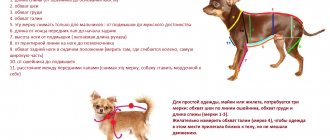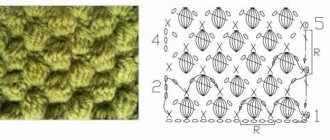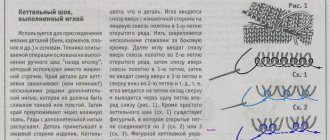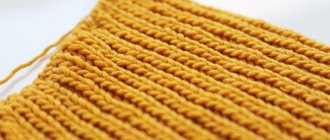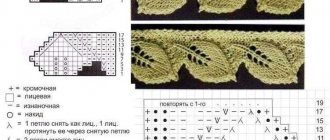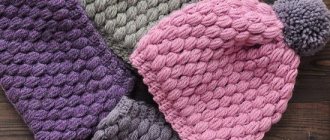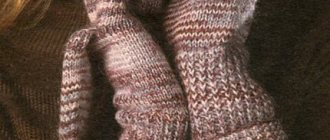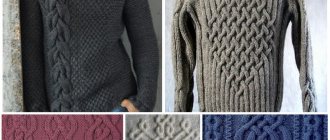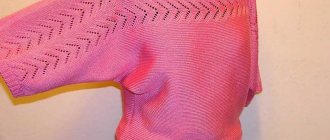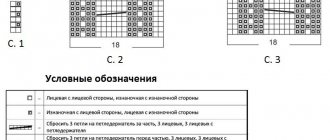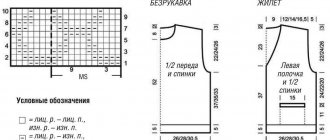The bonnet headdress came into fashion in Europe at the beginning of the 19th century. The origin of the word is from the Dutch “kaper”, which means hat. Initially, it was a piece of clothing for maids and served as a hair protector or nightcap. Later, thanks to the efforts of hatmakers, the hood became a fashionable hat and entered the wardrobe of society ladies and privileged persons.
A bonnet is an ideal winter headdress for women. And funny helmets, stylized to resemble the heads of different animals - from a baby dragon, a bear to a long-eared bunny - are perfect for kids.
Knitting a bonnet for a girl was the responsibility of every caring mother. The cap, decorated with ribbons and flowers, looked especially charming on babies aged 1 to 2 years.
A knitted bonnet will decorate the wardrobe of every charming girl . The design of the product is simple to implement; the pattern represents two halves of a cap and a shirtfront sewn along the edge.
Main features of the hood:
- The cap fits tightly to the child's head and is secured with a ribbon under the chin. It won't fly away from a gust of wind and will protect your baby's ears.
- In hot summers it perfectly protects from the sun's rays, and in cold winters it warms you up while walking.
- Lace and openwork bonnets, decorated with additional trinkets, serve as festive headdresses and perfectly complement weekend dresses and suits.
A simple way to knit a bonnet using MK photo
For work you will need:
- Yarn – 100 g (100% bouclé wool);
- Knitting needles - No. 5;
- Velvet ribbon – 60 cm.
Progress:
- Cast on 23 stitches and knit 3 cm in garter stitch.
- Then in every 4 r. add 1 p. before the last edge, only 4 times and get 27 p.
- When the height of the canvas reaches 20 cm, we begin decreasing. In each 2 r. 2 times 2 p. and 4 times 1 p., 19 p. remain. Advice! In order not to sew the two halves of the hood along the top of the head, you can proceed to knitting the second part without closing the loops!
- The left half is ready, we knit the right half symmetrically to the finished part.
- We sew the halves of the hood along the back of the head.
- To insulate the shoulders and chest, it is advisable to knit an additional piece to the hat. We cast on 18 stitches on the knitting needles and knit 70 cm in garter stitch.
- To attach the finished part, find the center of the scarf and align it with the back seam of the hood. We sew an improvised shirtfront along the entire lower circumference of the warm hat.
- We evenly pass the velvety braid along the joining seam and leave long ends for bow ties.
A red fluffy bonnet with a velvet ribbon, knitted by mother’s hands, will become a girl’s favorite thing in her fall-winter wardrobe.
We study the detailed creation of a hat for a boy with a description of the work
When knitting a hat for a boy, you don’t need to use ornate patterns; simple patterns are better. We suggest you use regular and English rubber bands. Let's start the master class.
To knit a bonnet hat you will need:
- wool yarn in blue shades;
- knitting needles No. 3.5.
It shouldn’t take much time to create a hat like the one in the photo. All steps are extremely simple and easy to master for beginners in knitting:
- We make the necessary measurements. We knit the base with a regular 1x1 elastic band.
- In total, we cast on 103 loops with a thread and continue to knit a 1x1 elastic band with the main thread. At a height of 4 cm, unravel the thread of the cast-on edge and remove the open loops onto an auxiliary needle.
- In the next row we knit together 1 loop from the main and auxiliary needles. Using knit and purl stitches we form a hem, and then continue knitting the English rib.
- Let's start making the pattern using an English elastic band. 1st row? alternate 1 knit stitch with 1 purl loop, ending with a purl stitch. The 2nd row and all subsequent rows are knitted like the first, but together they no longer knit two loops, but a pair of yarn over loops.
- When closing an English elastic in the classic way, a pair of yarn over loops should be knitted together, with a knit stitch, and a purl loop should be knitted with a purl stitch; in this case, the edge will not be elastic. To obtain an elastic edge of the elastic, the last row must be closed using method 3, but the pair of loops and yarn overs must be picked up with a needle as one loop.
- At a height of 13 cm, remove the last 37 loops from the auxiliary knitting needle and knit the central 29 loops, knitting together the last and first loops of the row from the auxiliary knitting needle 37 times.
- For the collar, we lift 34 loops along the edges of the side parts and remove 29 loops from the auxiliary needle, for a total of 97 loops. We continue to knit with an elastic band. After 14 cm we close the loops.
- We make the central seam of the collar. We moisten the finished hat and let it dry for a while.
Knitting a women's bonnet from mohair
Among Russian traditional headdresses, the kapor is presented in the form of a warm cap that extends into a wide mantle. Any home needlewoman can knit such a magnificent model with knitting needles with a detailed description.
The work scheme is presented in the form of parts that smoothly transform into each other. Knitting progress in the following several points:
- Using knitting needles No. 3, cast on 31 sts from a skein of chocolate fluffy yarn (consumption 400 g). We knit openwork strip A according to the presented pattern, where the circle is a yarn over, the triangle is 2 stitches, along with a slope to the left or right side. The length of the transverse strip is 110 cm. Advice! To ensure that the frill along the bottom edge has pointed ends, you can start with 3 stitches and increase the fabric to the desired width, adding 2 stitches in each face. R. The second pointed end is made by decreasing the loops.
- From the edge of the frill we cast on 180 stitches and knit strip B with garter stitch.
- In the next front row. decrease every 3 stitches by 2 together. Thus, we reduce the width of the canvas 2 more times. The width of part B is 5 cm.
- Next we move on to the dense neck part of the hood. We knit 2 stitches, 2 crossed stitches. It turns out a beautiful elastic band (part B) 5 cm wide. For beginners! Crossed knits are knitted like this, first the second knit behind the front wall, then the first - behind the back wall, both are removed on the right needle!
- The upper part of the hood (part D) is knitted with even stitches added to the sides. There should be a total of 90 stitches and the height of the fabric should be 17 cm.
- Next, the part is divided into 3 parts, the central 30 stitches are highlighted. They are knitted back and forth, grabbing the outer loops 2 together. Important! To understand how the upper part of the hood decreases, it is enough to remember knitting the heel of the toe. The central loops are knitted in the forward and reverse directions, with the last loop being knitted 2 together with the first loop of the outer part.
- When the main part of the hood is ready, all that remains is to decorate the lapel with an additional frill. The knitting pattern for the openwork part is represented by diagonal tracks, where the circles are yarn overs, and the triangles are 2, along with a tilt to the left. The width of the frill is approximately 20-25 cm, length 100-110 cm. Scheme 2 and 3.
- The edges of all parts can be beautifully decorated with a contrasting thread to emphasize the airiness and grace of the headdress. Crochet according to the pattern or decorate with a knitted frill; if desired, use ready-made lace and ribbons.
- As a fastener, you can use the frill ears and tie them with a knot, or skip the braid and decorate the ties with a beautiful bow.
LiveInternetLiveInternet
Quote from Natali_Zaz's message
Read in full In your quotation book or community!
Bonnet hat with knitting needles “Daisy”.
Interesting model.
Daisy pattern The number of loops must be a multiple of 4 + 1 loop + 2 edge loops 1 row: all knit stitches. Row 2: knit 1, * purl 3 stitches together (do not remove knitted loops from the knitting needle); yarn over; purl the three undone stitches again (= 1 daisy); 1 person *. Repeat from * to *. Row 3: Knit all stitches. Row 4: knit 1, purl 1, knit 1, * purl 3 stitches together (do not remove knitted stitches from the knitting needle); yarn over; purl the three undone stitches again (= 1 daisy); K1*, repeat from * to *, p1, k1. Repeat the pattern from the 1st to the 4th rows. I also found similar hats on the Internet. Perhaps someone will want to knit in a different version.
PATTERN WITH EXTENDED LOOPS. Row 1: K, p2, *k2, p2*. Repeat from ** to the end of the row, K. 2nd row: like all even rows in the pattern. (knit stitches with knit stitches, purl stitches with purl stitches) In further knitting we will need an elongated loop. It is knitted like this: insert the right knitting needle from the front side of the knitting between 6 and 7 loops on the left knitting needle, throw the thread on the right knitting needle, pull the loop to the front side of the fabric and slip it onto the left knitting needle before the first loop, then knit together the knitted loop and the first loop on the left needle. 3rd row: same as 1st row. Row 5: K, p2, *extended loop, k1, p2, k2, p2*. Repeat from ** to the end of the row, K. 7th row: as 1st row. Row 9: K, P2, K2, P2, *extended st, K1, P2, K2, P2*. Repeat from ** to the end of the row, K. Repeat from rows 3 to 10, ending next to the elongated loops.
And here are these hats without descriptions.
I made a diagram for the white cap.
More precisely, we remove 4 knit stitches and one purl stitch. The arrow looking up is: If you knit from the front side (in case of knitting in the round) Insert the right knitting needle under the stretched loops, insert the same knitting needle into the purl loop and knit it and the lowered loops together with the knit stitch (to make one loop). The headband in this hat is knitted in one thread, consisting of four stripes knitted in stockinette stitch. The hat itself is knitted in two threads.
You can also change the top pattern. Here I found several Options for knitting patterns. The description of the drawing for this header can be found here https://www.stranamam.ru/post/467724/
Honeycomb pattern: for 8 loops 1st row: knit 2nd row: purl 3rd row: 4p. cross to the left (put 2 stitches on the auxiliary needle before work, knit the next 2 stitches, then knit 2 stitches from the auxiliary needle), 4 stitches. cross to the right (put 2 stitches on the auxiliary needle behind the work, knit the next 2 stitches, then knit 2 stitches from the auxiliary needle). Repeat until the end of the row 4 row: purl 5 row: knit 6 row: purl 7 row: knit 8 row: purl 9 row: knit as row 3. in even (circular) rows, knit as the stitches look (knit) And here are the following patterns:
You can see many more patterns here https://www.xn--1000-j4d3a3car1a.xn--p1ai/index/uzory_spicami/0-27 https://avercheva.ru/?p=3228 You can knit an elastic band on knitting needles, and Finish the top of the hat with a crochet hook. It’s more convenient for someone to knit. Here are a few design options to choose from.
A description of this pattern and MK can be found here https://crochet-story.ru/vyazhem-kryuchkom/uzor-dlya-vyazaniya-kryuchkom-uzor-zvezdochka-kryuchkom
But how to knit such a strawberry (I think this is a drawing just for kids) can be done by watching the stages of knitting in the photo master class and video here
So let's get started. I will knit a bonnet "Daisy" for my fifteen-year-old daughter. For the hat, I bought two skeins of ALIZE LANAGOLD CLASSIC (100g/240m 49% wool 51% acrylic) I will knit in two threads. Here are my threads and knitting needles. To knit a hat you will need knitting needles from size 8 or more. We need straight and circular knitting needles. If there are no circular ones, you can knit with straight fabric, and then sew the hat by hand. I will knit with needles No. 8 because I have them in stock. Here's my sample
We calculate the loops.
I got 6.5 loops in 5 cm. 6.5/5 = 1.3 loops in 1cm We need to cast on the loops for the cross elastic on the knitting needles and knit straight 15 rows. Please note that in this particular hat the strings are not knitted separately, but the elastic itself serves as these “strings” on which the pompoms are attached. For the cross elastic, I need to pick up loops to make it 68 cm. I attached cm to my daughter and chose this length myself. 1.3*68 cm = 88.4 loops Round up, I need to cast on 89 loops . Next I knitted according to this pattern. Row 15 is the first row of the Daisy pattern
This is the kind of cross elastic band I get
Then continue knitting with the “daisy” pattern. In this case, only the middle loops are used, i.e., close 10 cm of elastic loops on each side, and knit the remaining loops with the “Daisies” pattern. I closed 13 loops on each side. Then 89p - 13p - 13p (for two ears) = 63 loops for the “Daisy” pattern Daisy pattern The number of loops should be a multiple of 4 + 1 loop + 2 edge loops 1 row: all knit stitches. Row 2: knit 1, * purl 3 stitches together (do not remove knitted loops from the knitting needle); yarn over; purl the three undone stitches again (= 1 daisy); 1 person *. Repeat from * to *. Row 3: Knit all stitches. Row 4: knit 1, purl 1, knit 1, * purl 3 stitches together (do not remove knitted stitches from the knitting needle); yarn over; purl the three undone stitches again (= 1 daisy); K1*, repeat from * to *, p1, k1. Repeat the pattern from the 1st to the 4th rows. So we have 63 loops - 1 loop - 2 edge loops = 60/4 = 15, just the right number of loops.
This is what I get.
I think this pattern should have been knitted with thicker needles. I had to bandage it a couple of times, the pattern was too tight. I tried to knit as loosely as possible. It’s still a bit tight near the elastic
Back view. I knitted on circular knitting needles (I don’t like to sew knitted things together) For the pattern I had to decrease the stitches at the back.
I knitted the crown using regular stockinette stitch. You can make reductions in any way you like. I made reductions like this. In an even row, where you need to knit three out of three loops, I simply knitted three loops together. I ended up with 30 stitches after decreasing. I knitted the next row with knit stitches without decreases. (I made decreases every other row.) Next, I made three decreases, knitting every 9th and 10th stitch together. Next row knit without decreases. We also make three decreases, knitting every 8th and 9th stitch together. And so on. Here is my result
My daughter is at school now, so the photo is on the balloon for now.
All I have to do is make three pompoms from yarn and sew them onto the hat. You can read how to make pompons and attach them here https://oleksi.ru/kak-sdelat-pompony/ Well, here is the finished hat on my model. I barely persuaded her to pose.
Good luck to everyone and smooth loops. Join us, the model is not very complicated. I will be glad to see everyone!
Source
